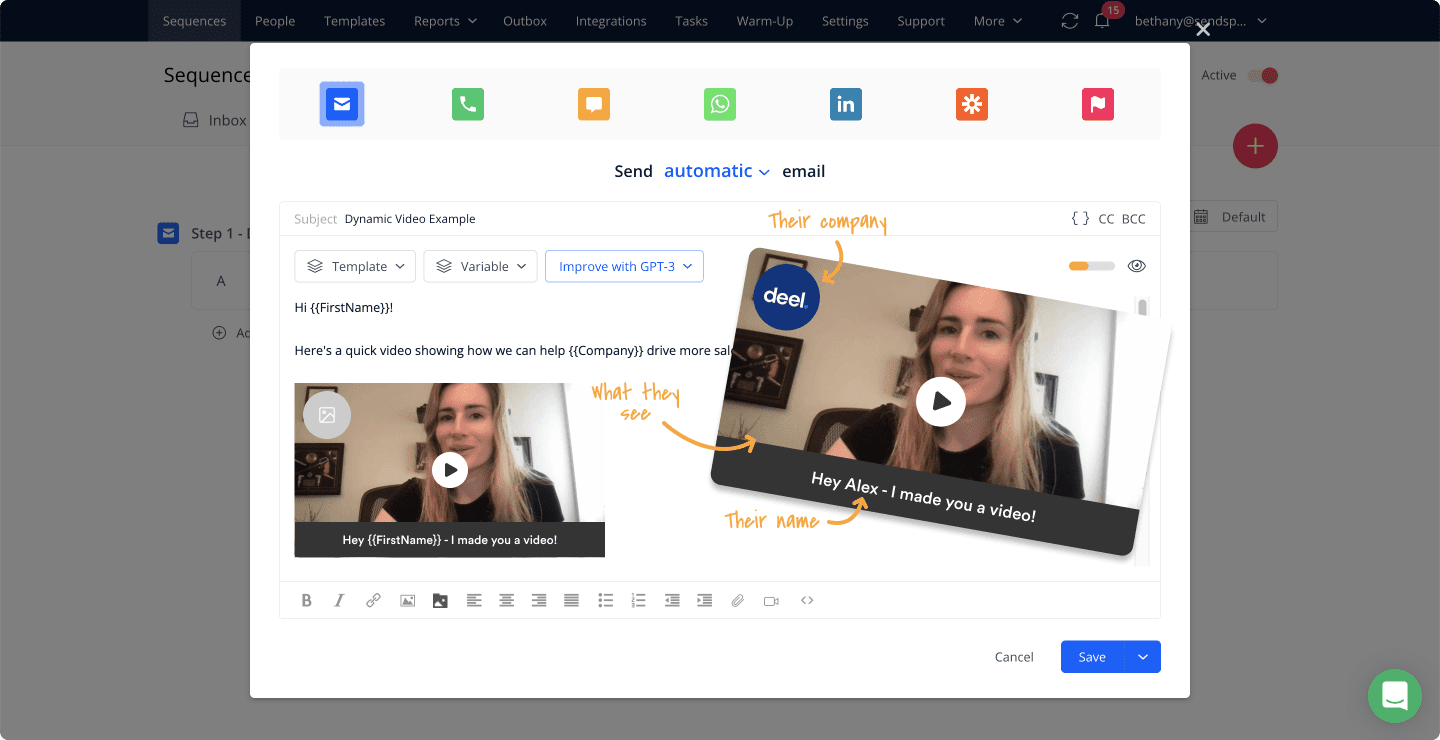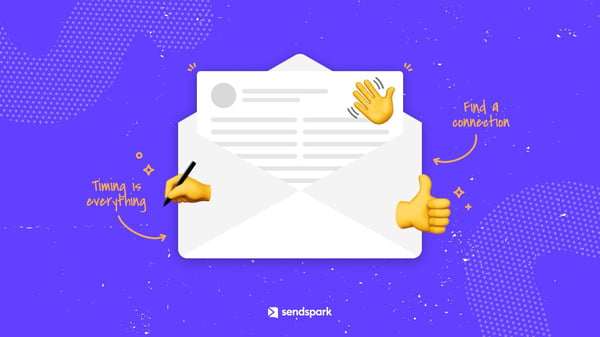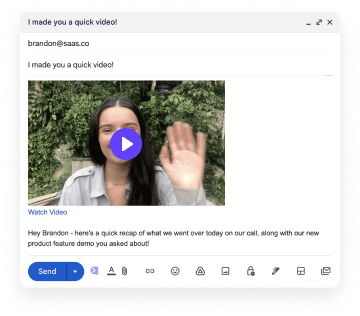Cold outreach emails. A phrase that makes some marketers cringe. They don't want to put in the effort. It isn't easy money. The ROI is bad.
You'll hear these excuses from people who don't want to put in the time and effort to make this kind of campaign successful. If you're reading this post, you're probably interested in doing it anyway.
We don't blame you. Genuinely personalized cold outreach emails can have a great ROI if you do it right. Becoming an expert can take your marketing career to new heights, as you'll be in an overwhelming minority.
The Basics of Personalized Cold Outreach Emails
When we say "personalized cold outreach emails," we don't mean "Hi, First Name!" and then a generic message. That's not going to cut it. You need to put in the effort to find out who your recipient is and what you can do for them.
Why Personalize Your Email?
Still not convinced? Here are some reasons why you should personalize your emails:
- People do business with people they know, like, and trust.
- Personalized emails show that you've done your research and you're not just spamming people with generic messages.
- It's a rare opportunity to stand out from the competition.
- You're more likely to get a response if you personalize your email.
- It shows that you value your recipient's time.
How to Personalize a Cold Outreach Email
The first step in personalizing a cold outreach email is to do your research. Spend some time learning about the person or organization you're reaching out to. What are their goals? What challenges are they facing? How can you help them?
By tailoring your message to address their specific needs, you'll improve the chances of getting a positive response. Always double-check your contact information before sending it.
Nothing says "I don't care about you" quite like an email with the wrong name or title. A little effort goes a long way in making a good first impression. You should also proofread your email for typos or grammatical errors. It gives a terrible first impression of you and the company you represent.
What to Avoid in Your Emails
Now that we've covered what you should do, let's consider what you should avoid. First and foremost, don't copy and paste the same message to everyone on your list. It’s the easiest way to get your messages marked as spam.
Don't use generic phrases like "I think our products would be a great fit for you." Wow. Sounds like you have absolutely no interest in doing any kind of business with this person. Congrats on wasting all of their time.
Instead, put serious thought into how you can help them solve their specific challenges.
Finally, don't send attachments without asking first. This can come across as pushy and sales-y, and it will likely get your message trashed. If you do have something to share, such as a case study or white paper, simply mention it in the email and ask if they're interested in taking a look.
7 Tips for Creating Genuinely Personalized Cold Outreach Emails
If you want to be the authority on personalized cold outreach emails, you're in the right spot. Below are seven tips to get your campaign off to an excellent beginning. Let's go.
1. Find a Connection
Finding a connection is one of the best ways to start a cold email. It could be something as simple as attending the same conference or being from the same town.
Mentioning this shared connection in your email will help you stand out from the hundreds of other emails they receive every day.
Keep it Short
When you're first reaching out to someone, it's important to keep your email short and sweet. No one wants to read a novel from a stranger.
Get to the point and explain why you're emailing them. If you have more to cover, include a link to more information or ask if they're available for a call.
Most importantly, don't try to sell them on your product or service in the first email. That comes later.
Coincidence? I Think Not
Truly personalized emails require not just research, but the right research. Mastering this craft will give you a much better idea of how you can serve this prospect. Learn about their company as well as their goals, their mission, and their challenges.
For example, let's say you're contacting a marketing director about content marketing services. In your prospecting email, you could mention a recent blog post they published and how you could help them drive more traffic to their site.
Or, if you're reaching out to a small business owner, you could mention how your product or service can help them save time or money.
You'll instantly stand out from the competition by showing that you're familiar with their work and challenges.
Mutual Connections
Another great way to personalize your email is by mentioning mutual connections. If you have a friend or colleague in common, be sure to bring them up.
A friend in common is a friend indeed, and it will instantly make you more trustworthy and increase the chances of getting a response.
You're emailing a potential client about your social media marketing services, and you and this prospect both know someone. You could say something like, "I was recently talking to XYZ about your social media presence, and she thought I might be able to help you."
This will show that you're not just randomly emailing them but have a genuine interest in helping them grow their business.
2. Timing is Everything
When you're sending a cold email, timing is everything. You don't want to be the first person to email them when they start a new job or the hundredth person to email them after they've had a baby.
Find out what's happening in their personal and professional lives. If you can, time your email around something positive, such as a new project they're working on or a big accomplishment.
A potential client just released a new product or service. You could congratulate them on their achievement and offer to help them promote it.
3. Don't Be a Robot
When you're writing a cold email, it's important to sound like a real person. Avoid using generic phrases like "I think you'll be interested in this" or "Thanks for your time."
Instead, use natural language and let your personality shine through. You’re more likely to get a response this way. Try sending a video prospecting email to add a human touch.
Even if you're automating your outreach, you can use a platform like Sendspark to embed videos in your email outreach (in platforms like Outreach, Hubspot, Reply, and more) and automatically personalize key parts of the video.

Be Helpful
When you're reaching out to someone, it's essential to be helpful. Don’t spend a single second thinking about how you’re going to benefit. Instead, focus on how you can help them.
For example, let's say you're emailing a potential client about your web design services. Instead of just touting your own skills, you could tell them which piece of content is driving the most traffic to their competitor. They'll see that you're knowledgable and able to help them achieve great results.
Keep it Short
When you're writing a cold email, it's important to keep it short. No one wants to read a lengthy sales pitch from someone they don't even know.
Get your point across in as few words as possible. People have limited time, and you should respect it.
4. Be Fluid with Formulas and Templates
There are a lot of great cold email templates out there. But it's important to remember that they're just starting points. Your own style and voice have a higher ROI than any online marketing tool if you know how to use them.
Let's say you're using a template to reach out to a potential client. Instead of starting with the standard, "It was great to meet you at XYZ conference," try something more personal.
You could say, "I loved your presentation at XYZ conference, and I'm a big fan of your work."
The person who receives your email will know that you're not just using a generic template but that you actually care about their work.
End With a Call to Action
If you want to see this kind of effectiveness from your campaign, remember to add a call to action at the end of your email.
Never end this kind of email without some sort of CTA. Give the recipient something specific to do, such as visiting your website or scheduling a meeting.
Without a call to action, your efforts will be fruitless. So make sure to include one at the end of your message.
5. Make Sure You're Delivering Real Value
The most important thing to remember when writing a cold email is that you need to deliver real value. If you're just trying to sell someone on your product or service, they're not going to respond.
Put effort into communicating how you can assist them. Show them that you're an expert in your field and that you're interested in helping them solve their problems.
6. Creativity Is a Big Deal
In a world where everyone is bombarded with emails, strive to be more creative. Generic, boring emails are going to get deleted without being read. So if you want your email to stand out, you need to be creative.
Think about what you can do to make your email more attractive. Can you include a personal story? Can you be funny? Can you make a bold claim?
The more creative you can be, the more likely it is that your email will actually get read.
But Don't Be Cute
Don't be cute or clever in your subject line. Your goal should be to get straight to the point. The recipient of your email is much more likely to delete it if they think it will be a waste of time.
Keep your subject line short and sweet. And make sure it's relevant to the email you're sending.
7. Know Their Pain Points
In today's business world, cold outreach emails are a necessary evil. They can be a great way to connect with potential customers and build relationships, but they can also quickly get your message deleted.
The key to effective cold outreach is understanding your recipient's pain points. Where are they struggling? What are their goals?
Once you grasp what they're trying to achieve, you can craft an email that offers a solution. If you can show them how your product or service can help them reach their goals, you'll be much more likely to make a positive impression.
So before you hit "send," take the time to understand what your recipient hopes to achieve. If you don't understand what they're trying to do and why they're doing it, then you either didn't research well or you don't care enough.
Make It About Them, Not You
Always keep the focus on the recipient. This means talking about their needs, their pain points, and how you can help them reach their goals.
If you make the email all about you and your product, they're not going to be interested. No one wants to read a sales pitch masquerading as an email. So make sure you're offering something of value and that the email is about them, not you.
The Takeaway
When writing a cold email, it's important to personalize it as much as possible in order to increase the chances of getting a response. Understand your recipient's pain points and address them in your email.
You should also make sure that the email is about them, not you. If you can do all this, you'll be well on your way to creating an effective cold outreach email.
By following these tips, you can write cold emails that will get responses. So don't be afraid to reach out to your target audience. With a little bit of effort, you can build better relationships and get the results you want.



